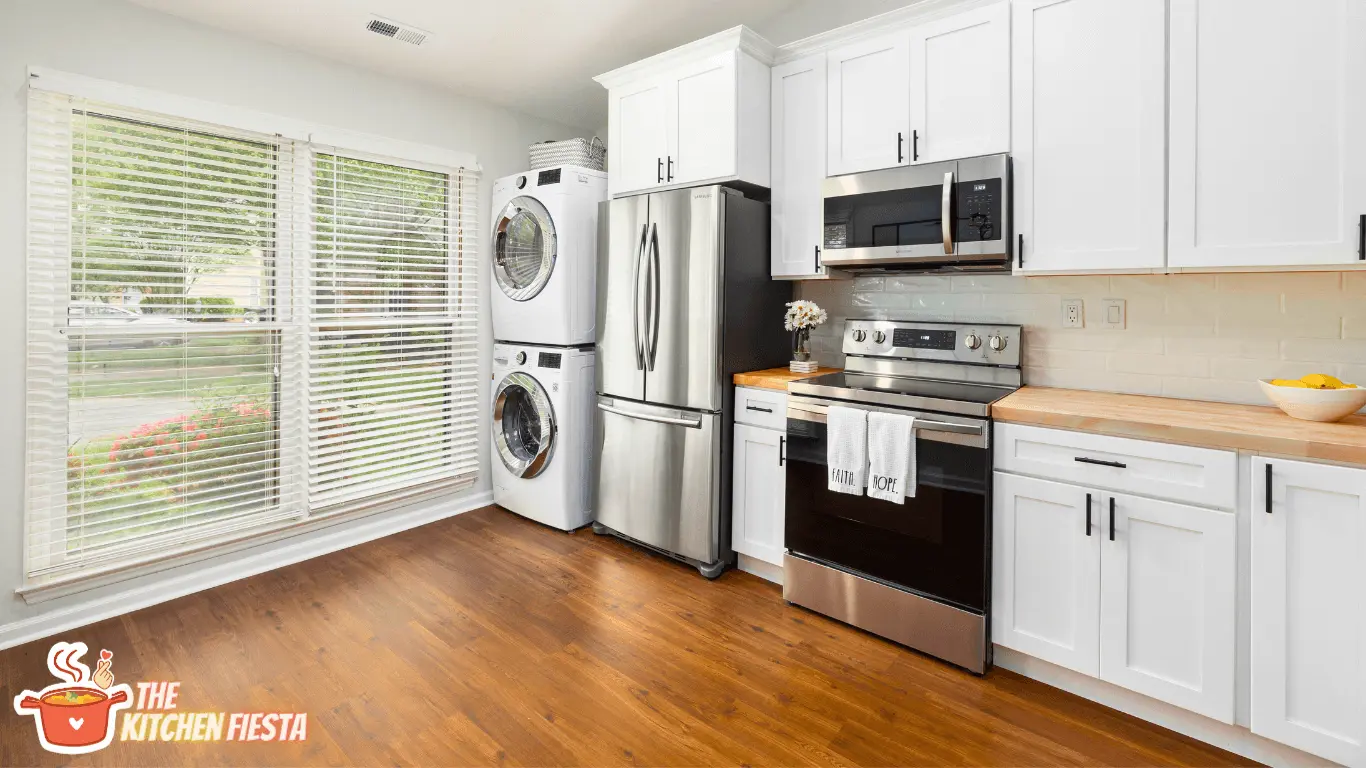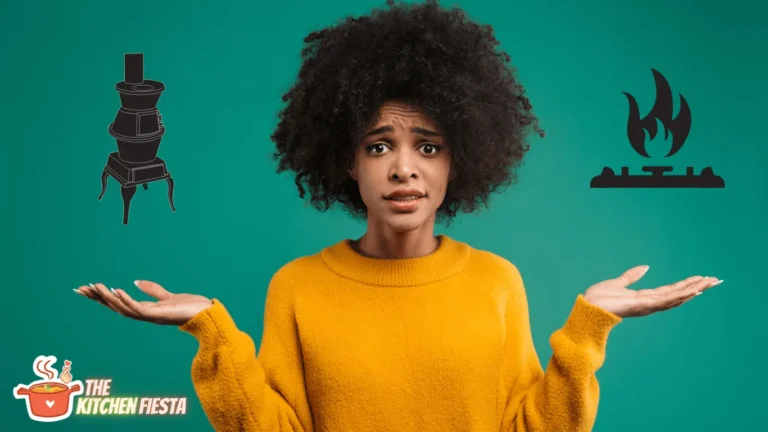Narrow Cabinet Next to Stove: Space-Saving Storage Solution

Narrow cabinets next to the stove are a popular storage solution for small kitchens. These cabinets are designed to fit in the space next to the stove, typically a small and narrow area often underutilized. Homeowners can maximize their storage space by installing a narrow cabinet next to the stove and keeping their cooking essentials within easy reach.
Narrow cabinets next to the stove come in various styles and sizes, making it easy to find one that fits your needs. Some cabinets feature pull-out drawers or shelves, while others have open doors to reveal adjustable shelves. Many cabinets also have built-in organizers, such as hooks for hanging utensils or dividers for storing pots and pans. With so many options available, homeowners can easily find a narrow cabinet that meets their storage needs and complements their kitchen decor.
Let’s find the benefits of incorporating a narrow cabinet next to the stove, offering a practical and space-efficient storage solution for small kitchens.
Understanding the Need for a Narrow Cabinet Next to Stove
In any kitchen, space is a valuable commodity. When designing a kitchen, it is essential to consider all the different elements and appliances that must be accommodated. One of the key appliances in any kitchen is the stove, which is often located against a wall.
It is common to install a narrow cabinet next to the stove to make the most of the available space. This cabinet is typically only a few inches wide, but it can provide a number of benefits.
One of the primary reasons for installing a narrow cabinet next to the stove is to provide additional storage space. This can be particularly useful for storing items frequently used during cooking, such as spices, oils, and utensils. Having these items close at hand can make cooking more efficient and enjoyable.
In addition to providing storage space, a narrow cabinet next to the stove can help create a more streamlined and organized kitchen. Having all the necessary items within reach can reduce clutter and make the kitchen feel more spacious.
Another benefit of a narrow cabinet next to the stove is that it can help to protect the wall from heat and grease. When cooking, it is not uncommon for hot oil or grease to splatter onto the wall behind the stove. Having a narrow cabinet in place can help catch any splatters and prevent them from damaging the wall.
A narrow cabinet next to the stove can be a valuable addition to any kitchen. Providing additional storage space, creating a more organized kitchen, and protecting the wall from heat and grease can help make cooking more enjoyable and efficient.
Key Considerations
When designing a kitchen, it’s essential to consider the placement of appliances and cabinets, especially those near the stove. A narrow cabinet next to the stove can be a convenient storage solution. Still, there are a few key considerations to keep in mind.
First and foremost, safety is a top priority. The stove generates a significant amount of heat, so it’s essential to ensure that the cabinet is made of a heat-resistant material and is positioned at a safe distance from the stove. Generally, the cabinet should be at least 3 inches away from any wood surface to allow air to pass through and disperse the heat.
Another important consideration is the size and placement of the cabinet. A narrow cabinet may be a space-saving solution. Still, it may not be practical if it can’t accommodate the items you need to store. Consider the height and depth of the cabinet, as well as the location of any shelves or drawers, to ensure that it can hold your pots, pans, and other cooking essentials.
In addition to size and placement, it’s also essential to consider the type of cabinet. Drawers can be a convenient option for storing utensils and spices, while cabinets with shelves can accommodate more oversized items like pots and pans. Consider your specific storage needs and choose a cabinet that will best meet them.
Finally, it’s essential to consider the overall design and aesthetic of the kitchen. A narrow cabinet next to the stove can be a functional addition. Still, it should also blend seamlessly with the rest of the kitchen. Consider the cabinet’s material, color, and style to ensure that it complements the other elements of the kitchen and creates a cohesive look.
Types of Narrow Cabinets
When it comes to designing a kitchen, every inch counts. Narrow cabinets are a great way to make the most of small spaces, especially those next to the stove. Here are some of the most popular types of narrow cabinets:
1. Pull-Out Cabinets
Pull-out cabinets are a great way to maximize space and organize your kitchen. They come in a variety of sizes and can be installed next to the stove for easy access to pots, pans, and cooking utensils. These cabinets are designed with a series of shelves that slide out, making it easy to find what you need without having to dig through a cluttered cabinet.
2. Open Shelf Cabinets
Open shelf cabinets are a great way to create a sense of openness in your kitchen. They are perfect for displaying your favorite dishes, cookbooks, and other kitchen essentials. These cabinets can be installed next to the stove and come in various sizes and styles to fit any kitchen design.
3. Corner Cabinets
Corner cabinets are a great way to use awkward spaces in your kitchen. They can be installed next to the stove and come in various sizes and styles to fit any kitchen design. These cabinets are designed with rotating shelves, making it easy to access your cooking supplies.
Installation Tips
When installing a narrow cabinet next to a stove, there are a few tips to keep in mind to ensure a successful installation.
Tip #1: Measure the Gap
Before purchasing a cabinet, measuring the gap between the stove and the adjacent wall or cabinet is essential. This will help determine the maximum cabinet width that fits the space. It’s recommended to leave at least 3 inches of space between the stove and any wood surface to prevent heat damage.
Tip #2: Consider the Functionality
Since the space next to a stove is limited, it’s essential to consider the cabinet’s functionality. Pull-out drawers may not be practical due to the narrow width. Still, shelves can be an excellent option for storing items such as spices, cooking oils, and utensils.
Tip #3: Choose the Right Material
When selecting a cabinet next to the stove, choosing a material that can withstand the heat is essential. Wood cabinets can be susceptible to warping or discoloration from the heat, so choosing a material such as metal or glass is recommended.
Tip #4: Hire a Professional
If you need more clarification about installing a cabinet next to your stove, it’s recommended to hire a professional to ensure a safe and successful installation. A professional can also help select the right cabinet and ensure it meets local building codes.
By following these installation tips, you can successfully install a narrow cabinet next to your stove while ensuring functionality and safety.
Maintenance and Care
Keeping the narrow cabinet beside the stove clean is crucial for aesthetic and safety reasons. Here are some tips to maintain and care for it:
- Regular cleaning: The cabinet should be cleaned regularly to prevent the accumulation of grease and grime. A solution of equal parts vinegar and water can wipe down the cabinet. Follow up with a dry cloth to ensure no moisture is left behind.
- Avoid harsh chemicals: Avoid using harsh chemicals or abrasive cleaners on the cabinet, as they can damage the finish. Instead, opt for mild cleaners that are gentle on the surface.
- Check for damage: Regularly check the cabinet for any signs of damage, such as cracks or loose hinges. If any damage is found, it should be repaired immediately to prevent further damage.
- Proper ventilation: Ensure that the area around the stove and the cabinet is properly ventilated to prevent heat and moisture buildup. This will also help to prevent the growth of mold and mildew.
- Store items correctly: Store items in the cabinet properly to prevent them from falling out and causing damage. Use organizers or dividers to keep items in place and prevent them from shifting during use.
Following these simple tips, the narrow cabinet next to the stove can be kept in good condition for years.
Benefits of Using a Narrow Cabinet Next to Stove
Narrow cabinets located next to the stove may seem impractical. Still, they can provide a range of benefits for the kitchen. Here are some of the benefits of using a narrow cabinet next to the stove:
- Convenient storage: A narrow cabinet next to the stove can store cooking utensils, pots, and pans, making it easy to access them while cooking. This can be especially useful for small kitchens where space is limited.
- Maximizes space: Narrow cabinets can fill in small spaces in the kitchen, maximizing the available space. This can be especially useful for kitchens with limited counter space or storage options.
- Easy to clean: Narrow cabinets are usually easier to clean than more expansive ones, as there is less surface area. This can be especially useful for busy cooks who only have a little time cleaning the kitchen.
- Adds visual interest: Narrow cabinets can add visual interest to the kitchen, breaking up the monotony of a row of standard-sized cabinets. They can also add color or texture to the kitchen design.
- Customizable: Narrow cabinets can be customized to fit the kitchen’s specific needs. For example, they can be designed to hold a spice rack, a cutting board, or a pull-out shelf for extra storage.
A narrow cabinet next to the stove can be a practical and stylish addition to any kitchen.
Potential Drawbacks
While a narrow cabinet next to the stove can be a convenient storage solution, there are also potential drawbacks. Here are a few things to keep in mind:
- Heat damage: If the cabinet is too close to the stove, the heat from the burners or oven could damage items stored inside. This is especially true for items made of plastic or other heat-sensitive materials. It’s essential to follow the manufacturer’s guidelines for how close the stove can be to any nearby cabinets or other objects.
- Fire hazard: A cabinet located too close to the stove could also be a fire hazard. If a pot or pan boils over or catches fire, nearby cabinets could quickly become engulfed. Again, it’s essential to follow safety guidelines for how far away the stove should be from nearby objects.
- Limited storage space: While a narrow cabinet can help store frequently used items, it may not offer enough storage space for larger or less commonly used items. This could lead to cluttered countertops or overflowing cabinets in other kitchen areas.
- Inconvenient access: Depending on the kitchen layout, a narrow cabinet next to the stove may be challenging. This could make it frustrating to retrieve items when cooking, mainly if the cabinet is located on the opposite side of the stove from where the cook is standing.
Overall, a narrow cabinet next to the stove can be a valuable addition to a kitchen. Still, it’s essential to consider potential drawbacks before installing one. By considering safety guidelines and being mindful of storage needs, homeowners can make the most of this convenient storage solution.
Conclusion
When installing a narrow cabinet next to a stove, remember a few essential considerations. Firstly, ensuring enough space between the stove and the cabinet is essential to prevent heat damage or fire hazards. As per the information provided by the search results, a minimum of 3 inches of space is recommended between the stove and any wood or combustible surface.
Additionally, it is essential to consider the materials used for the cabinet. Non-combustible materials such as metal or tile are recommended for cabinets next to a stove. This will help to minimize the risk of fire and heat damage.
Furthermore, it is important to consider the placement of the cabinet in relation to other elements in the kitchen. For example, if the cabinet is placed in a high-traffic area, it may be more prone to damage or wear and tear. Therefore, placing the cabinet in a less busy kitchen area may be more suitable.
Overall, considering these factors, it is possible to install a narrow cabinet next to a stove that is both functional and safe.
Frequently Asked Questions
What should I store in the cabinet next to my stove?
The cabinet beside your stove is excellent for storing pots, pans, and cooking utensils. You can also use it to frequently store spices, oils, and other cooking ingredients.
What is the recommended distance between a stove and a cabinet?
The recommended distance between a stove and a cabinet is at least 18 inches. This will help prevent any heat damage to the cabinet.
How can I maximize storage in a narrow kitchen cabinet?
You can use pull-out shelves, wire baskets, or narrow bins to maximize storage in a narrow kitchen cabinet. These can help you organize your items and make them more accessible.
Can I use any heat-resistant materials for a cabinet next to my stove?
Yes, there are heat-resistant materials that you can use for a cabinet next to your stove. Some options include stainless steel, ceramic tile, or a heat shield made of clear acrylic.
What narrow base cabinets with drawers can I use next to my stove?
If you are looking for narrow base cabinets with drawers that you can use next to your stove, some options include the IKEA SEKTION base cabinet with drawers and the Hampton Bay Shaker Assembled 18×34.5×24 in. Drawer Base Kitchen Cabinet, and the Diamond NOW Arcadia 18-in W x 35-in H x 23.75-in D Truecolor White Drawer Base Stock Cabinet.
How can I organize a narrow kitchen cabinet from IKEA?
To organize a narrow kitchen cabinet from IKEA, you can use IKEA’s VARIERA shelf insert, which can help you create additional shelves and maximize space. You can also use IKEA’s RATIONELL VARIERA pot lid organizer to store pot and pan lids vertically. Using IKEA’s VARIERA plastic bag dispenser can also help you keep your plastic bags organized and accessible.




